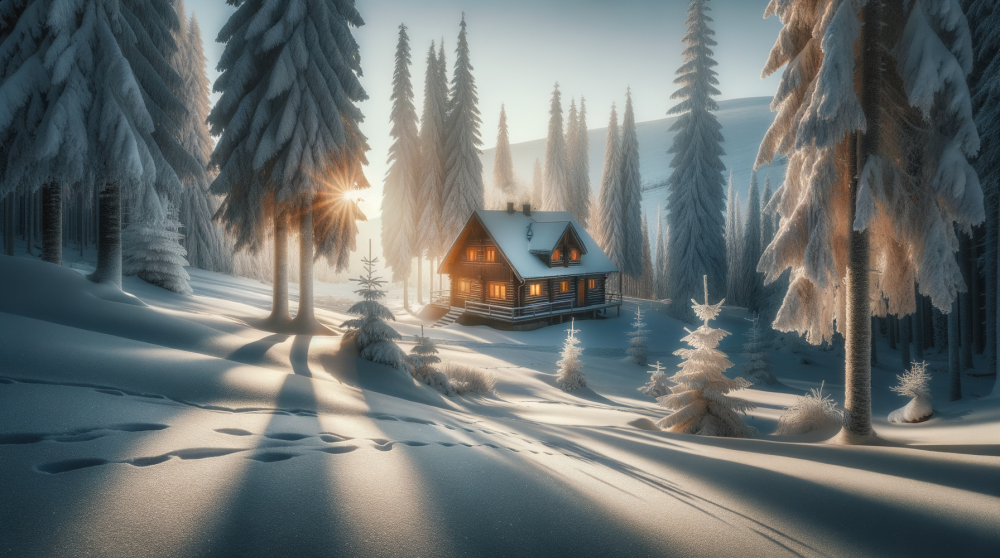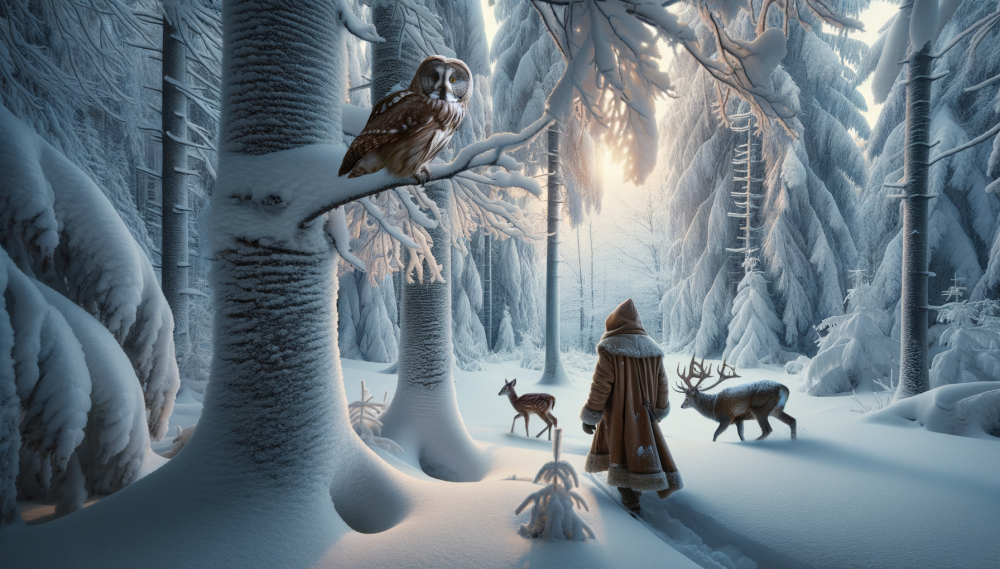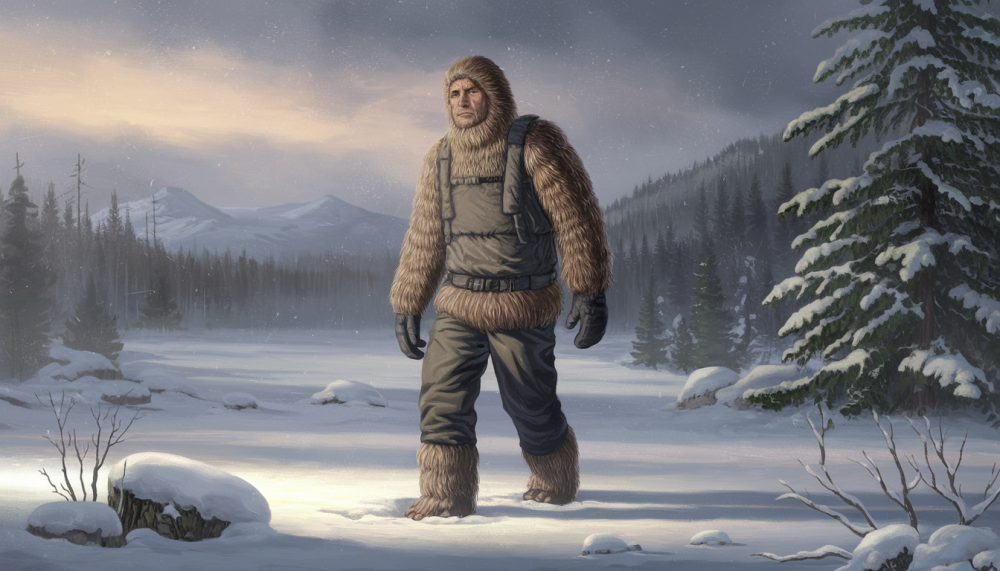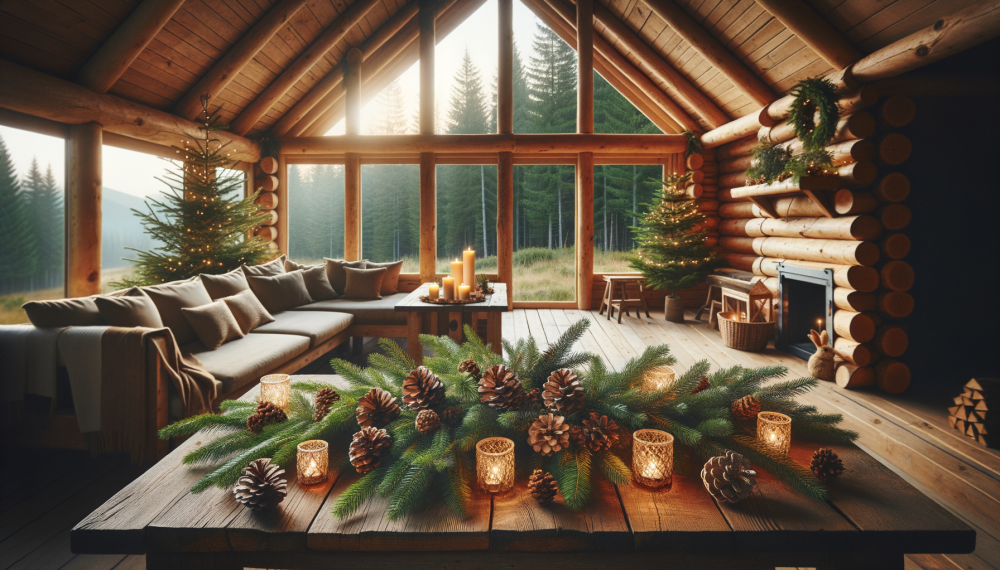
When the hustle and bustle of city life start wearing you down—especially during the holiday rush—there’s nothing quite like escaping into nature. Whether you’ve dreamed of an off-grid cabin hidden deep in the woods or plan a winter getaway a few hours from home, this guide celebrates the wisdom of the legendary Bigfoot. By tapping into nature’s rhythms, sharpening survival skills, and discovering the soul-soothing calm of winter wilderness, you can create the ultimate cozy cabin Christmas.
But this isn’t just about survival gear and checklists. The Bigfoot ethos is all about honoring the land, treading gently, and valuing simplicity. Below, you’ll find how to layer your winter wardrobe, build a safe shelter, forage sustainably, and bring a dash of forest magic into your holiday décor—all while preserving the peaceful aura of the wild. The ideas presented here go far beyond Christmas, helping you forge deeper connections with nature year-round. We’ll also pepper in top winter survival and décor keywords so you can easily find this guidance when you need it most.
So grab some cocoa, get comfy, and let’s dive into Bigfoot’s Winter Survival Guide: Lessons for a Cozy Cabin Christmas. By the end, you’ll have all the insight you need to embrace the frosty air, cultivate gratitude, and make your holiday season more magical than ever before.

Hey there! I’m Shawn,
Wildfoot Disclosure and Invitation
As an Amazon Associate I earn from qualifying purchases.
Some of the links in my blog posts are affiliate links to Amazon. This means I may earn a small commission if you decide to make a purchase, at no extra cost to you. These links are here to explore freely, with no pressure or obligation.
My blogs cover everything from Bigfoot theories and paranormal research to survival tips and personal stories. When I mention a book, tool, or piece of gear, it’s because I believe in it, use it, or have taken time to research it thoroughly.
You’ll also see connections to my other platforms, including TrailForge Gear and Paranormal Curiosities Realm all part of the same mission: to explore the unexplained and share what I find.
Thanks for reading, sharing, and supporting independent storytelling.
Shawn Thomas
Author & Creator of The Hidden Bloodlines of Bigfoot
Founder of Wildfoot Explores

1. Introduction: Embracing Nature’s Stillness

Amid the everyday chaos—emails, deadlines, social obligations—it’s easy to forget the simple therapeutic power of slowing down. Winter, in particular, offers a unique invitation to pause and reflect. When you retreat to a quiet cabin far removed from traffic jams and honking horns, the hush of the season seems amplified. Snow blankets the ground, muffling noise and revealing animal tracks instead. Trees stand adorned with frost, and the sun’s low arc casts long shadows that invite introspection.
Nature’s stillness acts like a reset button for the psyche. Spending a few days immersed in the whisper of pines and the crackle of ice underfoot can do wonders for your mental health. Moreover, coming back from such solitude often births new gratitude for the small details—be it a mug of hot chocolate enjoyed with a loved one or the fleeting brilliance of holiday lights in a cityscape.
Bigfoot’s Take on Stillness:
Bigfoot is famously elusive, and rarely spotted despite being the subject of countless legends. Perhaps one reason for this is his ability to live quietly within nature’s embrace. By stepping into Bigfoot’s metaphorical footprints, we can rediscover the serenity of nature and harness that quiet energy in our daily lives.
2. Harnessing Bigfoot Stealth: Rediscovering Winter Magic

One of the most enchanting aspects of a winter getaway is the chance to observe wildlife in its natural habitat. Moving gently and quietly, as Bigfoot reportedly does, allows you to witness nature unfiltered. Imagine spotting a family of deer browsing for food or glimpsing an owl perched overhead, unbothered by your presence. These intimate encounters with wildlife can become cherished holiday memories, especially if you focus on leaving minimal impact.
Tips for Moving Silently
- Soft Clothing: Opt for fabrics like wool or fleece that don’t rustle. Avoid noisy, stiff jackets and pants.
- Mindful Footsteps: Place your heel down first, then slowly shift your weight to the ball of your foot. This technique reduces crunching sounds on snow or fallen leaves.
- Slow Down: Resist the urge to hurry. Pausing frequently and scanning your surroundings gives both you and wildlife time to adjust.
Why Stealth Matters:
Aside from the thrill of spotting animals up close, moving quietly enhances your appreciation for the environment. The slower your pace, the more attuned you become to subtle details—a pattern in the snow, the shift in wind direction, or the distant pecking of a woodpecker. It’s a simple yet profound way of giving yourself permission to be fully present, a gift often overlooked during hectic holidays.
3. Essential Winter Survival: Layering for Warmth

Regarding winter survival, layering isn’t optional—it’s essential. Think of Bigfoot’s dense coat, which naturally insulates and adapts to fluctuating weather conditions. Humans don’t have fur, but we can effectively mimic this strategy by layering.
Three-Tiered Layering System
- Base Layer: Materials like merino wool or synthetic blends wick moisture away from your body, preventing dampness that can rapidly lower your temperature.
- Mid-Layer: Fleece, down, or other insulative materials trap body heat. This is your main warmth layer.
- Outer Shell: Windproof or water-resistant jackets shield you from the elements—snow, sleet, and biting wind.
Pro Tip:
Avoid cotton as a base layer. Cotton retains moisture and dries slowly, making you more susceptible to hypothermia. Choose moisture-wicking fabrics instead. Keep an extra mid-layer handy in your backpack, just in case the weather turns colder than expected.
Accessories for Optimal Warmth
- Insulated Hat or Beanie: A significant amount of heat escapes from your head.
- Gloves or Mittens: Mittens often hold warmth better, but gloves allow more dexterity.
- Neck Gaiter or Scarf: Protects your face from harsh winds.
- Wool Socks: Keep your feet dry and warm.
Using a strategic layering system not only keeps you comfortable but also ensures you can adapt quickly to shifting winter weather conditions.
4. Shelter-Building Basics: Creating Your Winter Haven

Building or selecting a robust shelter is crucial for any winter outing. You want something that shields you from wind, retains warmth, and blends with your surroundings—both for the aesthetic appeal and reduced environmental footprint.
Choosing the Right Location
- Natural Barriers: Look for areas already protected by rock outcrops, thick clusters of trees, or gently sloping terrain.
- Avoid Wet Areas: Even a patch of damp ground can sap heat from your body.
- Pay Attention to Wind Direction: Position the shelter entrance away from prevailing winds.
Once the perfect spot is found, you can construct a lean-to or a basic debris hut using fallen branches, leaves, and evergreen boughs. This approach requires minimal equipment and fosters a deeper connection to the wild. Think of it as the ultimate winter craft project—one that both respects nature and provides practical protection.
Insulation:
- Layer leaves or pine needles in the gaps of your shelter walls.
- Use extra boughs to create a bedding layer between you and the ground.
Building a winter shelter helps you appreciate not just the engineering aspect of survival, but also the intricate ways nature provides what we need if we look closely.
5. Mastering Fire Craft: From Primal Skill to Holiday Gathering

Fire-making might seem straightforward—just strike a match, right? But in winter conditions, wood can be damp, the wind can scatter sparks, and snow cover might impede airflow. Nevertheless, once mastered, creating a warm, crackling fire in a winter setting can feel almost mystical.
Steps to a Successful Winter Fire
- Gather Tinder: Look for dry materials like birch bark, pine resin, or dead grass. Stash tinder inside your jacket pocket so body heat can keep it dry.
- Process Kindling: Split larger sticks to expose their dry, inner core, which ignites more easily than the damp outer bark.
- Structure the Fire: Arrange tinder and kindling into a teepee shape for better airflow. Gradually add larger pieces of firewood as flames grow stronger.
- Safety First: Clear a firebreak (an area without fuel) around your fire pit. Keep water or snow nearby to extinguish the fire quickly if needed.

Introducing the Bigfoot Bushcraft Complete Emergency Fire Starter Kit – a must-have for any outdoor enthusiast. This kit is waterproof, windproof, and provides a 5+ minute burn time. It includes 80 fire plugs, a compact travel tin, and an extra thick ferro rod set. Don’t let unexpected situations catch you off guard – be prepared with the Bigfoot Bushcraft Complete Emergency Fire Starter Kit. Click here to explore more
Fire as Focal Point:
In the context of a cabin Christmas, a well-built fire serves more than just heat; it becomes the gathering spot. Friends and family can circle around the dancing flames, sharing hot cocoa or mulled wine and swapping stories. This communal aspect underscores why humans have long cherished the warmth of a shared campfire.
6. Winter Foraging and Sustenance: A Mindful Approach

Winter may appear devoid of foraging opportunities at first glance, but if you know where to look, nature still offers a modest pantry. The key is to practice caution and proper identification—ingesting unknown plants or fungi can have dire consequences.
What You Might Find
- Nuts (e.g., Acorns, Hazelnuts): Often overlooked but can be ground into flour or roasted.
- Cold-Tolerant Greens: Certain hardier wild greens may survive under light snow.
- Late-Season Berries & Rose Hips: Some remain clinging to branches, providing Vitamin C.
- Mushrooms: Species like oyster mushrooms can appear on logs in cooler weather.
Pro Tip:
Always consult a field guide or an expert if you’re unsure about a plant or mushroom. In winter, plant identification can be tricky due to the lack of foliage. Err on the side of caution: when in doubt, skip it.
Nutrient-Dense Provisions
In addition to any foraged food, pack high-calorie, nutrient-rich items like trail mixes, peanut butter, and jerky. These staples provide an energy boost without weighing you down, making them ideal for winter treks.
Safety and Sustainability
- Don’t Over-Forage: Take only what you need, leaving enough for local wildlife.
- Respect Protected Lands: Some areas prohibit foraging for conservation reasons.
- Stay Hydrated: Cold air is deceptively drying. Melt snow or carry ample water.
Foraging in winter can add an adventurous twist to your holiday cabin experience, reminding us that the Earth’s bounty is ongoing, albeit more subtle.
7. Crafting a Cozy Cabin Christmas: Bringing the Outdoors In

You don’t need fancy decorations or a shopping spree to turn a remote cabin into a cozy holiday retreat. Let nature be your inspiration. Combine soft lighting with pinecones, evergreen boughs, and other natural elements to create a festive and peaceful atmosphere that complements the surroundings.
Simple, Rustic Décor Tips
- Gather Pine Branches: Lay them as a table centerpiece or above door frames.
- Use Natural Textiles: Swap synthetic tablecloths for burlap or linen to anchor the earthy vibes.
- Ambient Lighting: Candles, LED lanterns, and string lights (resembling fireflies) create a soft, magical glow.
Why Nature-Inspired Décor?
Not only does it look beautiful, but nature-inspired décor also ties your indoor celebration to the winter wonderland outside your window. Every time you catch the piney fragrance of a handmade wreath or glimpse a glittered pinecone ornament, you’ll feel more in tune with the forest. And that sense of connection can profoundly elevate your Christmas spirit.
8. Pinecone Ornaments and Earth-Toned Décor

If you’re searching for a budget-friendly and meaningful Christmas ornament idea, pinecones are a great option. These little wonders are free to collect (just remember to respect local regulations and wildlife habitats), and they can be used in a variety of DIY crafting projects.
Crafting Pinecone Ornaments
- Clean and Dry Them: Lay your pinecones out on newspapers to dry and remove any debris.
- Add a Touch of Sparkle: Lightly dust them with natural glitter or eco-friendly paint for an understated holiday shimmer.
- Attach a Ribbon or Twine Loop: Hang them from your Christmas tree or place them in a decorative bowl as a table accent.
Embracing Earth Tones
Holiday color palettes often revolve around bright reds and greens. While that’s classic, consider earth tones like warm browns, olive greens, and beige. These soothing hues can beautifully complement the snowy white backdrop outside. Think plush blankets, textured pillows, and subtle metallic accents that catch the soft glow of candles and string lights.
Bringing Nature Inside
- Branches & Stones: A simple branch in a vase or some smooth river stones on a tray can become conversation pieces.
- Dried Flowers: Sprigs of lavender or dried seed pods add a romantic winter touch.
- Evergreen Garland: Wrap door frames or a mantel with garlands accented by pinecones and ribbons.
Connecting your cabin’s interior design to the forest outside doesn’t just create a cohesive visual theme—it feels authentic, centering your holiday experience around nature’s quiet beauty.
9. Bigfoot-Themed Winter Feast: Rustic Recipes and Tips

A hearty meal is the heart of any holiday gathering, and a Bigfoot-inspired twist can make it memorable. Imagine a table spread that highlights both rustic comfort foods and wild, foraged ingredients. It’s a small nod to the primal side of winter living, serving as a conversation starter for friends and family.
Bigfoot Feast Essentials
- Hearty Soups and Stews: Use root vegetables, beans, grains, and any available wild mushrooms. These simmering one-pot wonders warm you from the inside out.
- Rustic Casseroles: Shepherd’s pie or vegetable gratins bring a layered, cozy charm to the table.
- Wild Berry Desserts: If you’ve managed to forage winter berries or leftover fall harvest, incorporate them into pies or cobblers.
Foraged Flair:
Try incorporating acorns (properly leached of tannins) into flour for biscuits, or add wild mushrooms to your gravy. These unique ingredients nod to the forest around you, tying the meal to the environment.
Setting the Table
- Pinecone Placeholders: Glue a small name tag on a pinecone for a personal, woodland-inspired touch.
- Twig Coasters: Gather fallen sticks and twigs, tie them together with jute twine, and you’ve got a homemade coaster set.
- Evergreen Centerpiece: A simple row of pine boughs, candles, and pinecones across the table adds a scenic focal point.
Feasting like Bigfoot means prioritizing hearty, nourishing foods that fuel winter adventures. More importantly, it’s about gathering people together to share warmth, stories, and a respect for nature’s gifts.
10. Key Woodland Survival Skills for Holiday Adventures

Whether your cabin is fully equipped or not, knowing some basic outdoor survival skills can truly enhance your holiday experience. These skills aren’t just for emergencies – they also help you connect more deeply with the natural world.”
Fire Craft
We covered this in detail above, but it’s worth reiterating: fire is central to both survival and comfort. Knowing how to gather and prepare materials is key. The glow of a crackling winter fire transforms your surroundings into a mesmerizing holiday scene.
Navigation Know-How
- Map and Compass: Always carry a physical map and compass, even if you have GPS devices. Batteries can fail in cold conditions.
- Landmark Recognition: Practice identifying prominent trees, boulders, or ridgelines. This skill helps you orient yourself when trails become obscured by snow.
- GPS Apps: If you use a smartphone, download offline maps.
Primitive Tool Craft
- Walking Sticks: Finding a sturdy branch can make steep or slippery terrain safer.
- Tent Stakes or Anchors: Carve simple stakes from deadwood if you need to secure a tarp or tent.
- Emergency Cordage: Twisting strips of bark can serve as makeshift rope in a pinch.
Why Learn These Skills?
They provide confidence and adaptability. Winter weather can be unpredictable. If a snowstorm blows in, you’ll have the knowledge to stay safe and relatively comfortable. Plus, demonstrating these skills can be a fun, educational aspect of your holiday adventure, especially if kids are involved—they’ll love learning how to build a fire or read a compass.
11. Sustainable Gift-Giving: A Greener Holiday Approach

.During the holiday season, we tend to go overboard with everything – too much food, too many gifts, and way too much waste. However, by adopting a more sustainable approach to gift-giving, we can add more depth and meaning to our celebrations. This can reflect the respect that Bigfoot probably has for his forest home. Eco-Friendly Gift Ideas
- Reusable Items: Metal water bottles, beeswax wraps, cloth shopping bags, and bamboo utensils.
- Locally-Sourced Products: Handcrafted items from local artisans support small businesses and reduce carbon footprints from transportation.
- Experience-Based Gifts: Instead of more “stuff,” gift a class, a nature retreat, or a hiking trip.
DIY Presents
- Homemade Candles or Soaps: Personalize scents and shapes for your loved ones.
- Knitted Scarves and Hats: Warm, cozy, and a testament to your creativity.
- Infused Oils or Vinegars: Bottle up a tasty infusion using herbs or dried chiles for a gift that’s practical and thoughtful.
Wrapping Sustainably
- Fabric Wraps (Furoshiki): A Japanese tradition that uses cloth squares for wrapping, which can be reused over and over.
- Recycled Paper: Brown paper bags or old newspapers decorated with stamps or drawings.
- Natural Trimmings: Twine, sprigs of pine, dried orange slices, and pressed flowers.
Embracing eco-friendly, handmade, or local gifts not only lightens the environmental impact but also lends an intimate sincerity to the process. Each gift tells a story and carries the essence of your holiday values.
12. Conclusion: Channeling Bigfoot’s Spirit Beyond the Holidays

In conclusion, let’s keep Bigfoot’s spirit alive all year round, not just during the holidays. When we think about Bigfoot’s legendary stories, one important lesson shines through: we should treat the earth with care. By being mindful of our impact, making sustainable choices, and showing respect for nature, we can make our winter experiences even more special. The holiday season shouldn’t just be about gifts and gatherings – it’s a chance for us to feel grateful and rejuvenated.
Embracing Nature and Simplicity
When you focus on quiet moments—like the way snow sparkles under moonlight or the soft crackle of a fire—the hustle of modern life fades. It’s a chance to reconnect with what truly matters: our relationships, our inner calm, and our responsibility to safeguard the wild beauty around us.
Carrying the Spirit Forward
Don’t let this awakened perspective fade when the tinsel and ornaments are packed away. Carry the Bigfoot spirit of respectful coexistence into each season. Make more trips into the wilderness, learn new survival skills, and continue exploring the synergy between nature’s rhythms and your own.
Looking to the Future
- Plan New Adventures: Whether you aim for more winter escapades or you want to explore a summer wilderness retreat, keep building your knowledge base.
- Pass It On: Teach friends and family about layering, firecraft, and responsible foraging. Inspire them to follow in Bigfoot’s quiet footprints.
- Practice Gratitude: Let each foraged nut, each silent step in snowy drifts, and each glittering pinecone ornament remind you of the abundant gifts nature offers.
Ultimately, a Bigfoot-style winter survival approach isn’t just about “making it” through the cold. It’s about thriving—finding delight and harmony in nature’s hush, forging deeper connections with loved ones, and cherishing each moment of peace that this season grants. When we welcome the winter hush, practice eco-friendly values and craft warm holiday traditions, we transform an ordinary Christmas into a truly magical one. And that, perhaps, is the greatest lesson Bigfoot can offer us all.



